Effect of the Severe Plastic Deformation on the Corrosion Resistance of a Tantalum–Tungsten Alloy
Abstract
1. Introduction
2. Materials and Methods
3. Results and Discussion
4. Conclusions
Author Contributions
Funding
Institutional Review Board Statement
Informed Consent Statement
Conflicts of Interest
References
- Yan, M.; Wang, X.; Zhou, H.; Liu, J.; Zhang, S.; Lu, Y.; Hao, J. Microstructure, mechanical and tribological properties of graphite-like carbon coatings doped with tantalum. Appl. Surf. Sci. 2021, 542, 148404. [Google Scholar] [CrossRef]
- McNamara, K.; Beloshapkin, S.; Hossain, K.M.; Dhoubhadel, M.S.; Tofail, S.A.M. Tantalum coating inhibits Ni-migration from titanium out-diffusion in NiTi shape memory biomedical alloy. Appl. Surf. Sci. 2021, 535, 147621. [Google Scholar] [CrossRef]
- Novakowski, T.J.; Sundaram, A.; Tripathi, J.K.; Gonderman, S.; Hassanein, A. Deuterium desorption from ion-irradiated tantalum and effects on surface morphology. J. Nucl. Mater. 2018, 504, 1–7. [Google Scholar] [CrossRef]
- Zhang, T.; Deng, H.W.; Xie, Z.M.; Liu, R.; Yang, J.F.; Liu, C.S.; Wang, X.P.; Fang, Q.F.; Xiong, Y. Recent progresses on designing and manufacturing of bulk refractory alloys with high performances based on controlling interfaces. J. Mater. Sci. Technol. 2020, 52, 29–62. [Google Scholar] [CrossRef]
- Wang, S.; Wu, Z.H.; Xie, M.Y.; Si, D.H.; Li, L.Y.; Chen, C.; Zhang, Z.; Wu, Y.C. The effect of tungsten content on the rolling texture and microstructure of Ta-W alloys. Mater. Charact. 2020, 159, 110067. [Google Scholar] [CrossRef]
- Liu, Y.; Liu, S.; Deng, C.; Fan, H.; Yuan, X.; Liu, Q. Inhomogeneous deformation of {111}<uvw> grain in cold rolled tantalum. J. Mater. Sci. Technol. 2018, 34, 2178–2182. [Google Scholar] [CrossRef]
- Jakubowicz, J.; Adamek, G.; Sopata, M.; Koper, J.K.; Kachlicki, T.; Jarzebski, M. Microstructure and electrochemical properties of refractory nanocrystalline Tantalum-based alloys. Int. J. Electrochem. Sci. 2018, 13, 1956–1975. [Google Scholar] [CrossRef]
- Gypen, L.A.; Brabers, M.; Deruyttere, A. Corrosion resistance of tantalum base alloys. Elimination of hydrogen embrittlement in tantalum by substitutional alloying. Mater. Corros. 1984, 35, 37–46. [Google Scholar] [CrossRef]
- De Souza, K.A.; Robin, A. Influence of concentration and temperature on the corrosion behavior of titanium, titanium-20 and 40% tantalum alloys and tantalum in sulfuric acid solutions. Mater. Chem. Phys. 2007, 103, 351–360. [Google Scholar] [CrossRef]
- Robin, A. Corrosion behavior of niobium, tantalum and their alloys in boiling sulfuric acid solutions. Int. J. Refract. Metals Hard Mater. 1997, 15, 317–323. [Google Scholar] [CrossRef]
- Aimone, P.; Moser, K. Working with tantalum and tantalum alloys. In CORROSION 2003; NACE Int.: San Diego, CA, USA, 2003. [Google Scholar]
- Maric, M.; Muránsky, O.; Karatchevtseva, I.; Ungár, T.; Hester, J.; Studer, A.; Scales, N.; Ribárik, G.; Primig, S.; Hill, M.R. The effect of cold-rolling on the microstructure and corrosion behaviour of 316L alloy in FLiNaK molten salt. Corros. Sci. 2018, 142, 133–144. [Google Scholar] [CrossRef]
- Liu, Y.H.; Liu, S.F.; Zhu, J.L.; Deng, C.; Fan, H.Y.; Cao, L.F.; Liu, Q. Strain path dependence of microstructure and annealing behavior in high purity tantalum. Mater. Sci. Eng. A 2017, 707, 518–530. [Google Scholar] [CrossRef]
- Greene, N.D.; Saltzman, G.A. Effect of plastic deformation on the corrosion of iron and steel. Corrosion 1964, 20, 293t–298t. [Google Scholar] [CrossRef]
- Luo, H.; Wang, X.; Dong, C.; Xiao, K.; Li, X. Effect of cold deformation on the corrosion behaviour of UNS S31803 duplex stainless steel in simulated concrete pore solution. Corros. Sci. 2017, 124, 178–192. [Google Scholar] [CrossRef]
- Štefec, R.; Franz, F. A study of the pitting corrosion of cold-worked stainless steel. Corros. Sci. 1978, 18, 161–168. [Google Scholar] [CrossRef]
- Wu, X.; Yang, M.; Yuan, F.; Wu, G.; Wei, Y.; Huang, X.; Zhu, Y. Heterogeneous lamella structure unites ultrafine-grain strength with coarse-grain ductility. Proc. Natl. Acad. Sci. USA 2015, 112, 14501–14505. [Google Scholar] [CrossRef]
- Rofagha, R.; Erb, U.; Ostrander, D.; Palumbo, G.; Aust, K.T. The effects of grain size and phosphorus on the corrosion of nanocrystalline Ni-P alloys. Nanostruct. Mater. 1993, 2, 1–10. [Google Scholar] [CrossRef]
- Wang, S.G.; Shen, C.B.; Long, K.; Yang, H.Y.; Wang, F.H.; Zhang, Z.D. Preparation and electrochemical corrosion behavior of bulk nanocrystalline ingot iron in HCl acid solution. J. Phys. Chem. B 2005, 107, 2499–2503. [Google Scholar] [CrossRef]
- Wang, S.G.; Shen, C.B.; Long, K.; Zhang, T.; Wang, F.H.; Zhang, Z.D. The Electrochemical Corrosion of Bulk Nanocrystalline Ingot Iron in Acidic SulfateSolution. J. Phys. Chem. B 2006, 110, 377–382. [Google Scholar] [CrossRef]
- Lv, J.; Luo, H. The effects of cold rolling temperature on corrosion resistance of pure iron. Appl. Surf. Sci. 2014, 317, 125–130. [Google Scholar]
- Abdulstaar, M.; Mhaede, M.; Wagner, L.; Wollmann, M. Corrosion behaviour of Al 1050 severely deformed by rotary swaging. Mater. Des. 2014, 57, 325–329. [Google Scholar] [CrossRef]
- Wang, Z.; Zhu, F.; Zheng, K.; Jia, J.; Wei, Y.; Li, H.; Huang, L.; Zheng, Z. Effect of the thickness reduction on intergranular corrosion in an under–aged Al–Mg–Si–Cu alloy during cold–rolling. Corros. Sci. 2018, 142, 201–212. [Google Scholar] [CrossRef]
- Xiang, S.; He, Y.; Shi, W.; Ji, X.; Tan, Y.; Liu, J.; Ballinger, R.G. Chloride-induced corrosion behavior of cold-drawn pearlitic steel wires. Corros. Sci. 2018, 141, 221–229. [Google Scholar] [CrossRef]
- Zeng, Y.; Yang, F.; Chen, Z.; Guo, E.; Gao, M.; Wang, X.; Kang, H.; Wang, T. Enhancing mechanical properties and corrosion resistance of nickel-aluminum bronze via hot rolling process. J. Mater. Sci. Technol. 2021, 61, 186–196. [Google Scholar] [CrossRef]
- Zhang, J.; Ma, G.Q.; Godfrey, A.; Shu, D.Y.; Chen, Q.; Wu, G.L. Orientation dependence of the deformation microstructure of Ta-4% W after cold-rolling. In Proceedings of the IOP Conference Series: Materials Science and Engineering, Risø, Denmark, 4–8 September 2017; Volume 219, p. 012051. [Google Scholar]
- Ma, G.; Godfrey, A.; Chen, Q.; Wu, G.; Hughes, D.A.; Hansen, N. Microstructural evolution of Ta-4%W during cold rolling. In Proceedings of the IOP Conference Series: Materials Science and Engineering, Risø, Denmark, 2–6 September 2019; Volume 580, p. 012041. [Google Scholar]
- Ma, G.; Hughes, D.A.; Godfrey, A.W.; Chen, Q.; Hansen, N.; Wu, G. Microstructure and strength of a tantalum-tungsten alloy after cold rolling from small to large strains. J. Mater. Sci. Technol. 2021, 83, 34–48. [Google Scholar] [CrossRef]
- Ma, G.; He, Q.; Luo, X.; Wu, G.; Chen, Q. Effect of recrystallization annealing on corrosion behavior of Ta-4%W alloy. Materials 2018, 12, 117. [Google Scholar] [CrossRef] [PubMed]
- Ma, G.; Wu, G.; Shi, W.; Xiang, S.; Chen, Q.; Mao, X. Effect of cold rolling on the corrosion behavior of Ta-4W alloy in sulphuric acid. Corros. Sci. 2020, 176, 108924. [Google Scholar] [CrossRef]
- Liu, Q. A Simple and Rapid Method for Determining Orientations and Misorientations of Crystalline Specimens in TEM. Ultramicroscopy 1995, 60, 81–89. [Google Scholar] [CrossRef]
- Wang, S.G.; Sun, M.; Liu, S.Y.; Liu, X.; Xu, Y.H.; Gong, C.B.; Long, K.; Zhang, Z.D. Synchronous optimization of strengths, ductility and corrosion resistances of bulk nanocrystalline 304 stainless steel. J. Mater. Sci. Technol. 2020, 37, 161–172. [Google Scholar] [CrossRef]
- Fan, H.Y.; Liu, S.F.; Guo, Y.; Deng, C.; Liu, Q. Quantifying the effects of surface quality on texture measurements of tantalum. Appl. Surf. Sci. 2015, 339, 15–21. [Google Scholar] [CrossRef]
- Xu, Y.; Zhang, Z.; Mao, S.; Ma, Y. Corrosion behavior of different tantalum crystal faces in NH4Br–ethanol solution and DFT calculation. Appl. Surf. Sci. 2013, 280, 247–255. [Google Scholar] [CrossRef]
- Wang, W.; Alfantazi, A. Correlation between grain orientation and surface dissolution of niobium. Appl. Surf. Sci. 2015, 335, 23–226. [Google Scholar] [CrossRef]
- Schreiber, A.; Schultze, J.W.; Lohrengel, M.M.; Kármán, F.; Kálmán, E. Grain dependent electrochemical investigations on pure iron in acetate buffer pH 6.0. Electrochim. Acta 2003, 51, 2625–2630. [Google Scholar] [CrossRef]
- Kuhlmann-Wilsdorf, D.; Hansen, N. Geometrically necessary, incidental and subgrain boundaries. Scripta Metall Mater. 1997, 25, 1557–1562. [Google Scholar] [CrossRef]
- Haraszti, F.; Kovacs, T. Plastic deformation effect of the corrosion resistance in case of austenitic stainless steel. In Proceedings of the IOP Conference Series: Materials Science and Engineering, Miskolc, Hungary, 3–7 October 2016; IOP Publishing Ltd.: Bristol, UK, 2017; Volume 175, p. 012048. [Google Scholar]
- Wang, Y.; Jin, J.; Zhang, M.; Liu, F.; Wang, X.; Gong, P.; Tang, X. Influence of plastic deformation on the corrosion behavior of CrCoFeMnNi high entropy alloy. J. Alloys Compd. 2022, 891, 161822. [Google Scholar] [CrossRef]
- Lv, J.; Luo, H.; Liang, T.; Guo, W. The effects of grain refinement and deformation on corrosion resistance of passive film formed on the surface of 304 stainless steels. Mater. Res. Bull. 2015, 70, 896–907. [Google Scholar]
- Hughes, D.A.; Hansen, N. High angle boundaries formed by grain subdivision mechanisms. Acta Mater. 1997, 45, 3871–3886. [Google Scholar] [CrossRef]
- Hughes, D.A.; Hansen, N. The microstructural origin of work hardening stages. Acta Mater. 2018, 148, 374–383. [Google Scholar] [CrossRef]
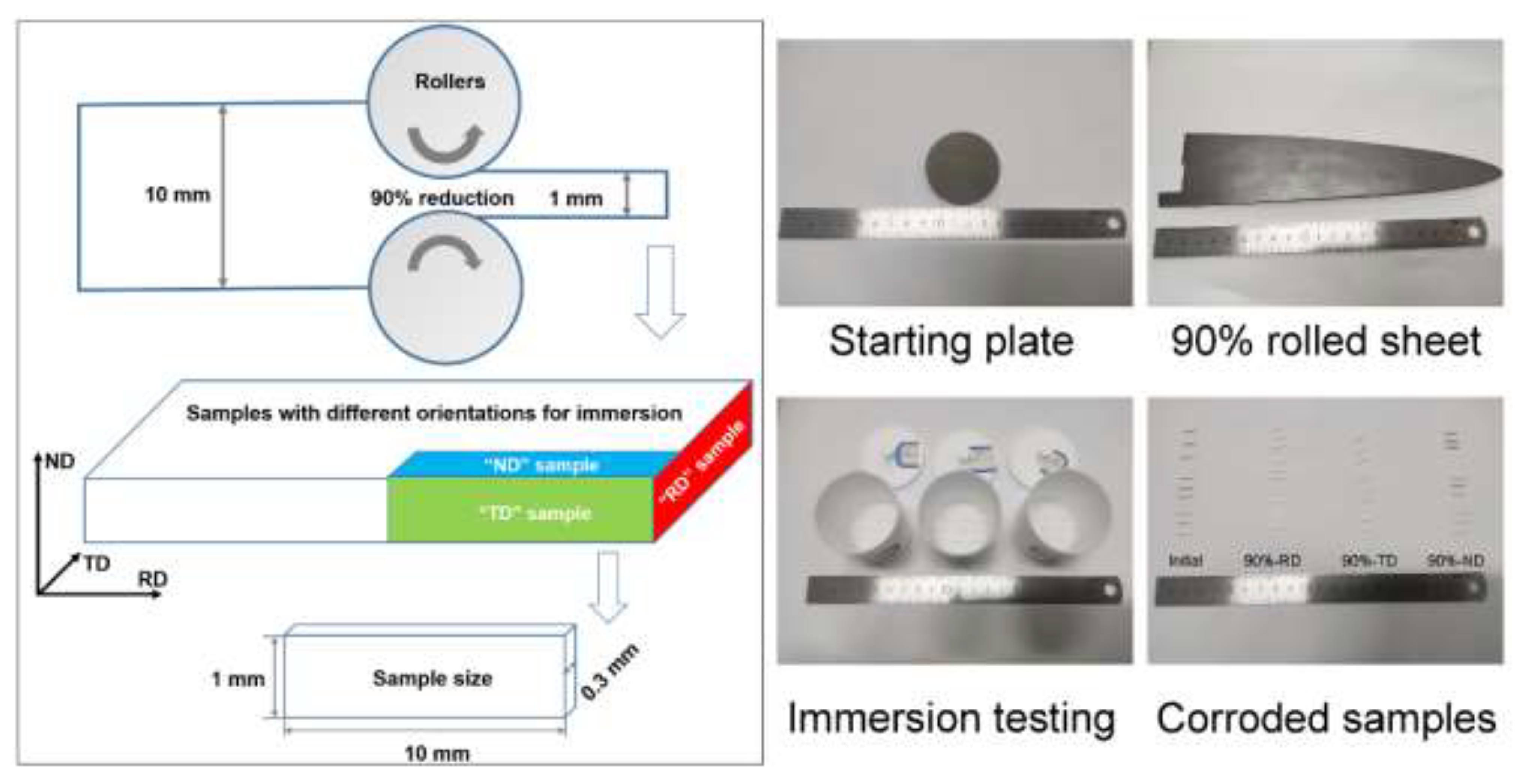
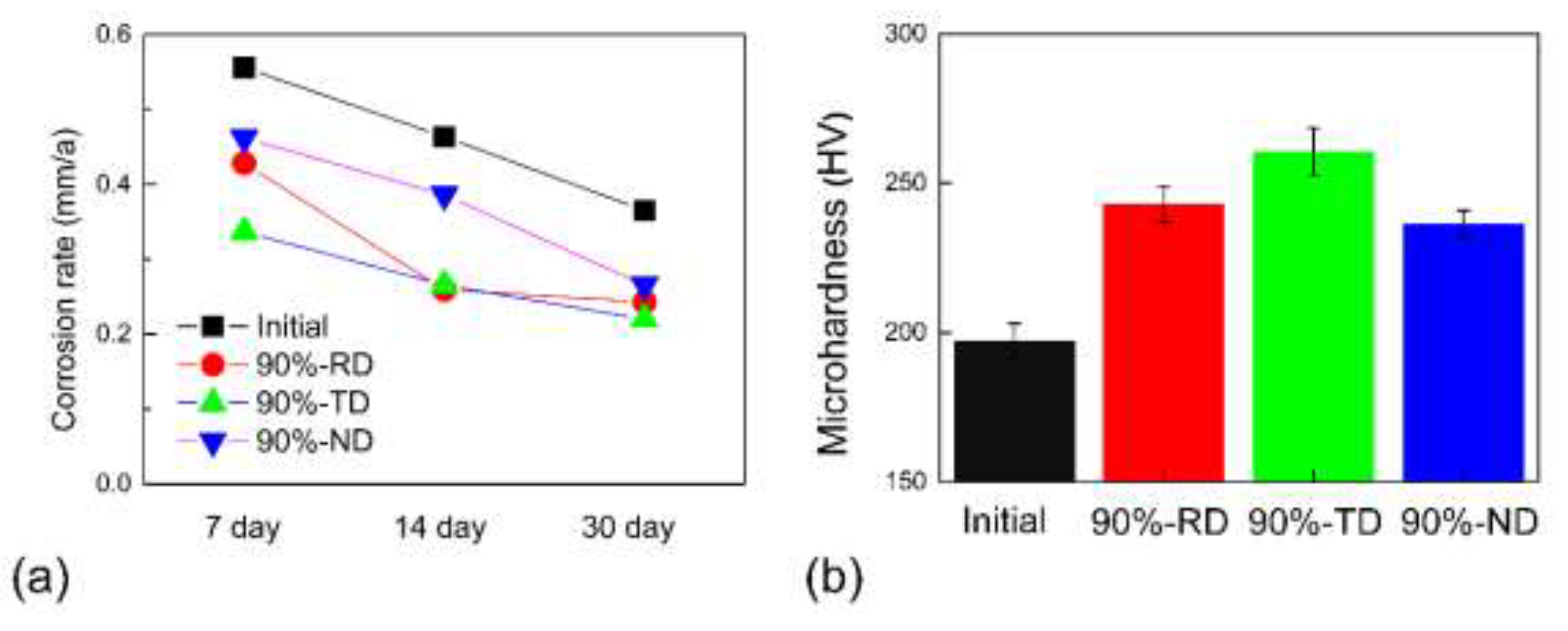


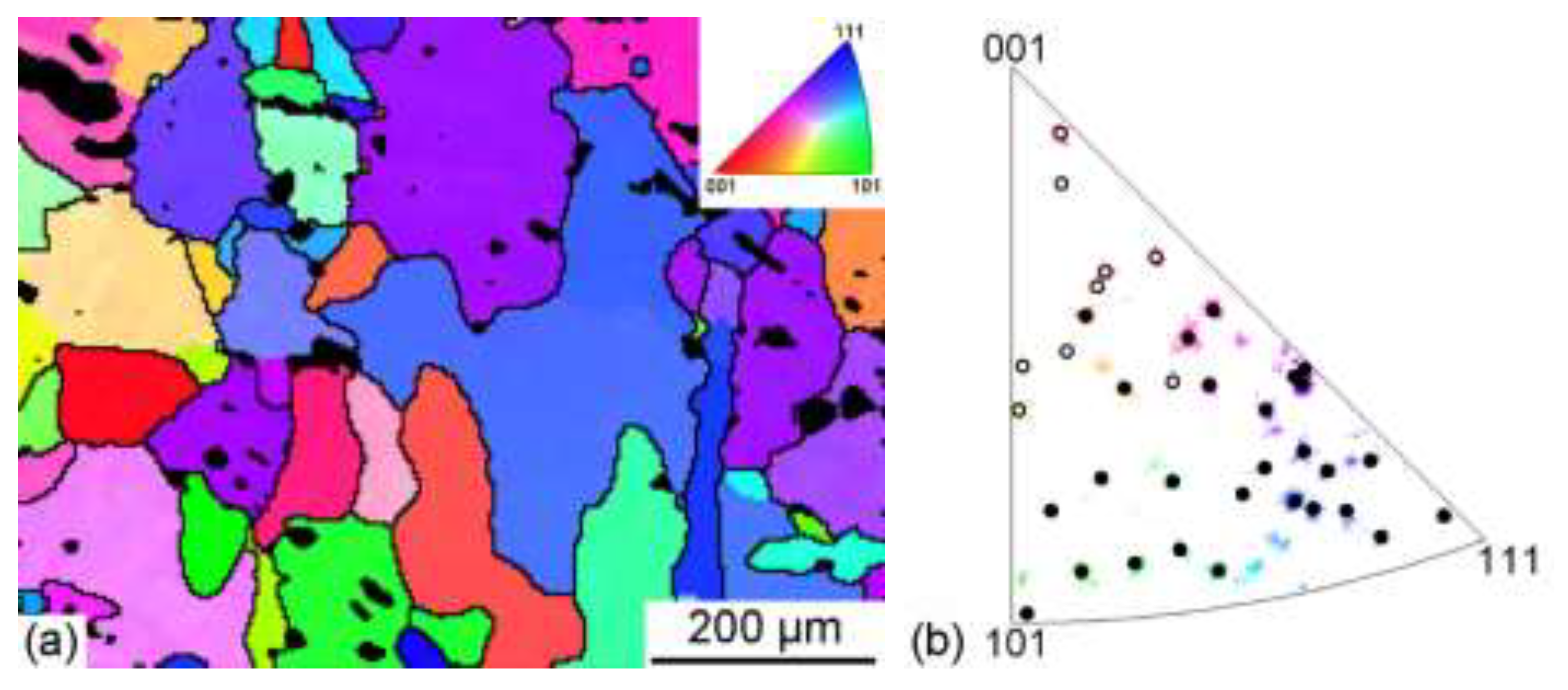
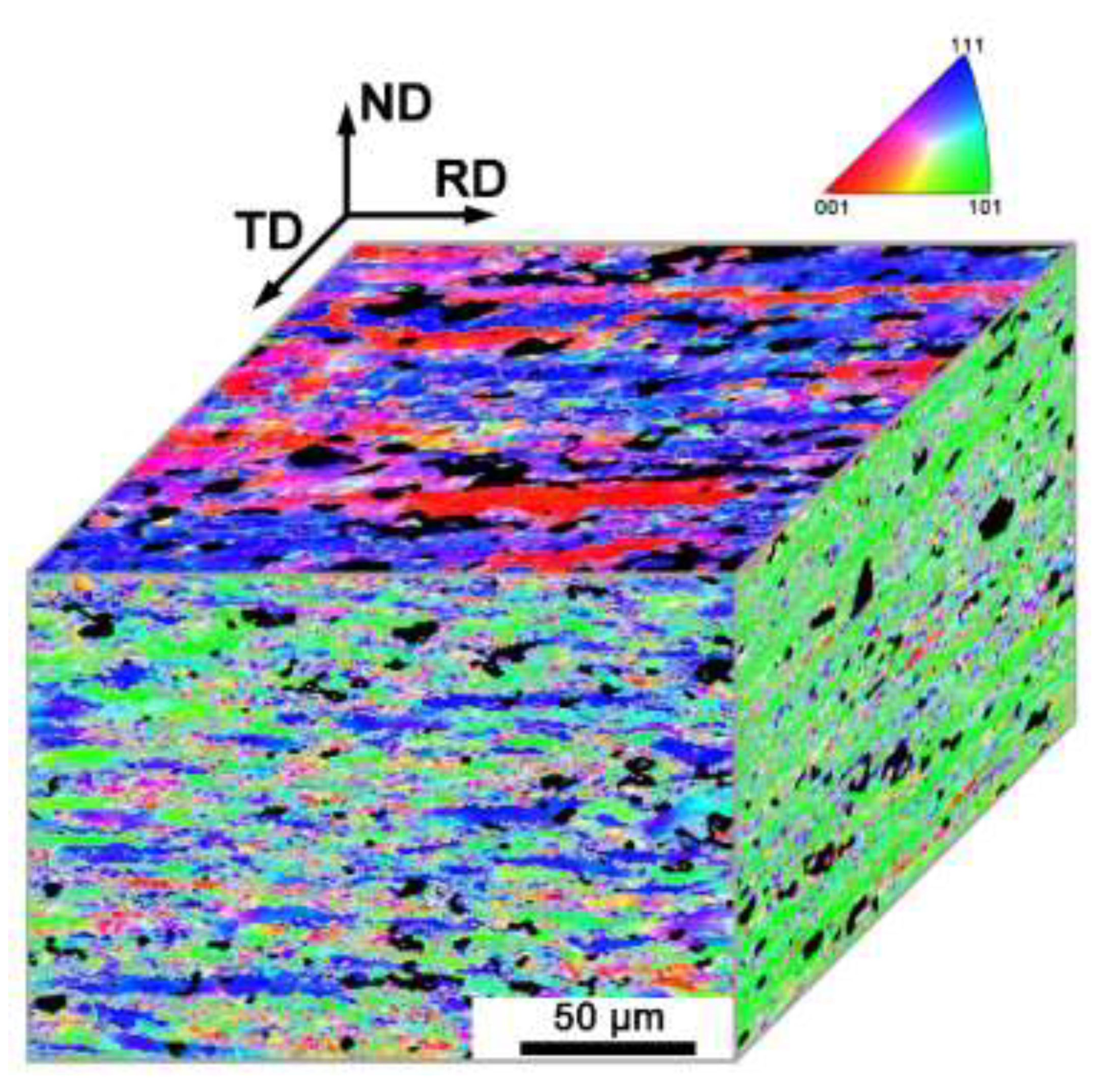
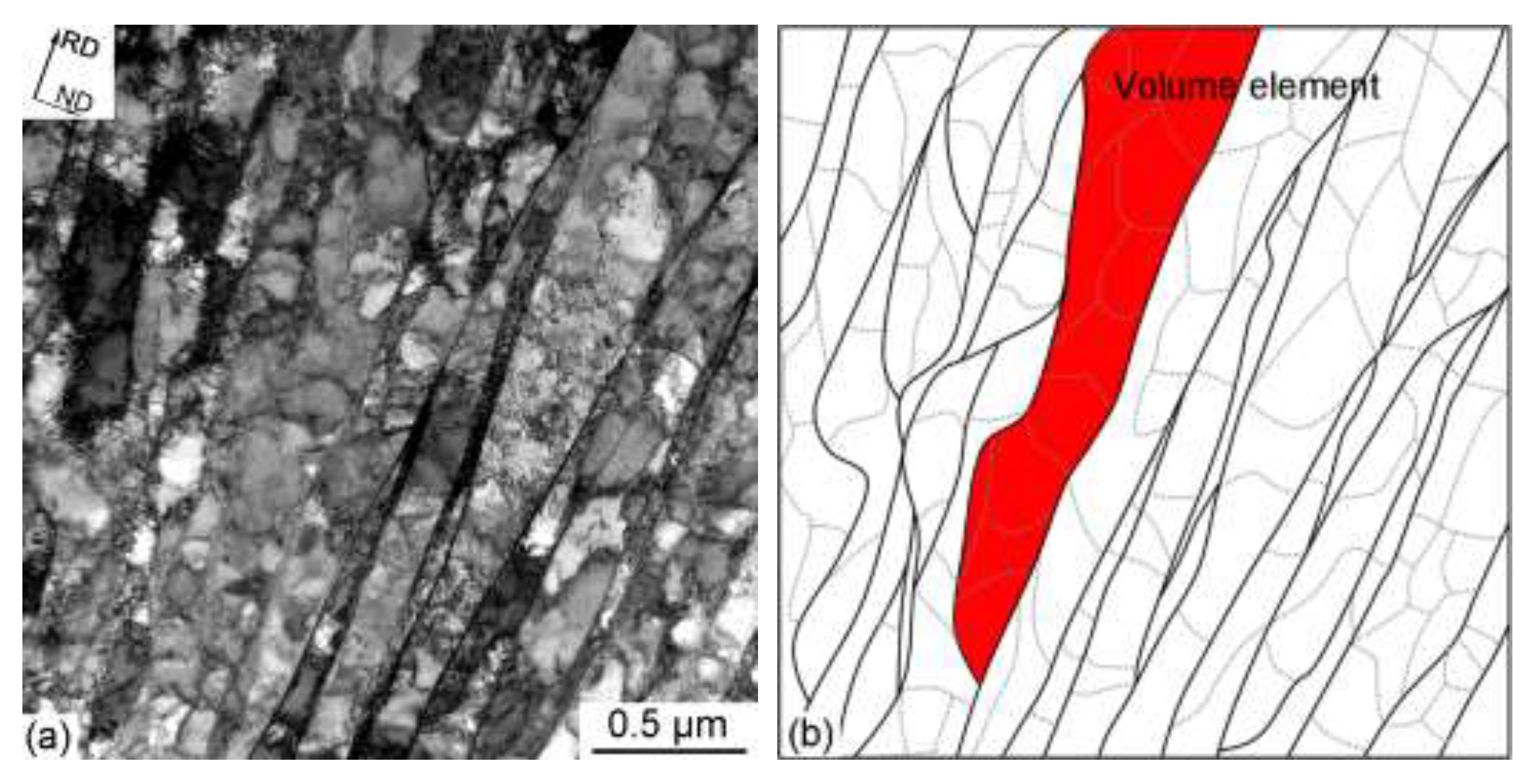
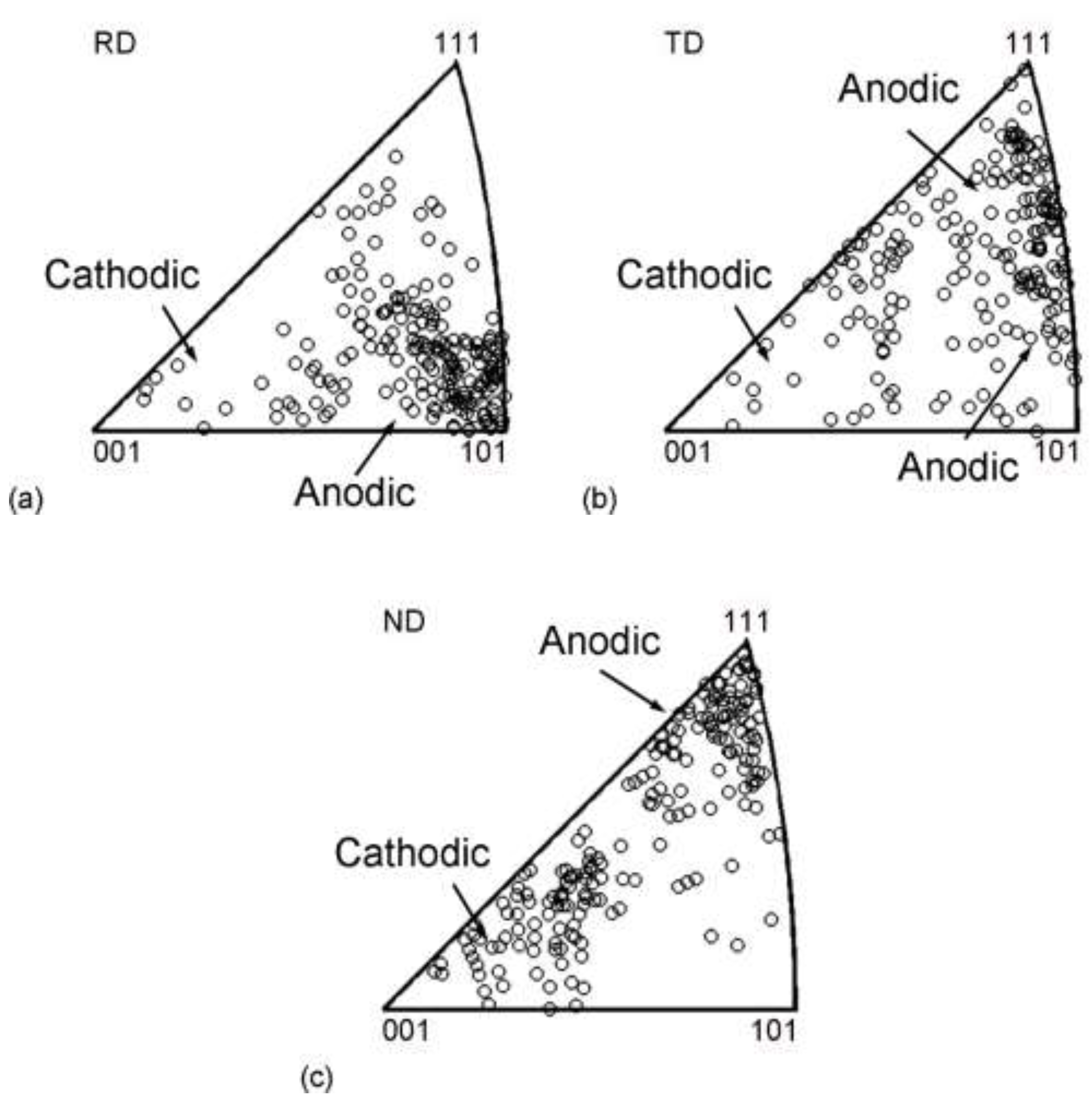
Publisher’s Note: MDPI stays neutral with regard to jurisdictional claims in published maps and institutional affiliations. |
© 2022 by the authors. Licensee MDPI, Basel, Switzerland. This article is an open access article distributed under the terms and conditions of the Creative Commons Attribution (CC BY) license (https://creativecommons.org/licenses/by/4.0/).
Share and Cite
Ma, G.; Zhao, M.; Xiang, S.; Zhu, W.; Wu, G.; Mao, X. Effect of the Severe Plastic Deformation on the Corrosion Resistance of a Tantalum–Tungsten Alloy. Materials 2022, 15, 7806. https://doi.org/10.3390/ma15217806
Ma G, Zhao M, Xiang S, Zhu W, Wu G, Mao X. Effect of the Severe Plastic Deformation on the Corrosion Resistance of a Tantalum–Tungsten Alloy. Materials. 2022; 15(21):7806. https://doi.org/10.3390/ma15217806
Chicago/Turabian StyleMa, Guoqiang, Man Zhao, Song Xiang, Wanquan Zhu, Guilin Wu, and Xinping Mao. 2022. "Effect of the Severe Plastic Deformation on the Corrosion Resistance of a Tantalum–Tungsten Alloy" Materials 15, no. 21: 7806. https://doi.org/10.3390/ma15217806
APA StyleMa, G., Zhao, M., Xiang, S., Zhu, W., Wu, G., & Mao, X. (2022). Effect of the Severe Plastic Deformation on the Corrosion Resistance of a Tantalum–Tungsten Alloy. Materials, 15(21), 7806. https://doi.org/10.3390/ma15217806





